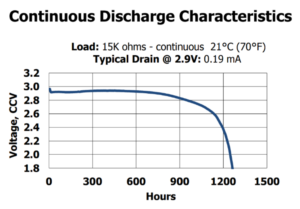So you have decided to reduce the risk of battery leakage damaging your precious Williams arcade or pinball board by replacing the existing AA batteries with a lithium (CR2032) replacement. Great! Lithium batteries like the CR2032 tend to leak much less than alkaline batteries so this is a good generally a good idea.
Note that I said “much less than alkaline batteries“ – lithium batteries can still leak causing damage to your PCB!
You need to maintain them like any other battery system.
So now the question is, how long will the lithium battery last before it needs to be replaced? I would suggest that you replace the battery as soon as it voltage-under-load drops to 2.8v. Why 2.8? Two good reasons. First, here is a discharge graph pulled from the Energizer CR2032 datasheet:

Notice that the voltage starts to fall off a cliff at about 2.8 volts – this is important. Alkaline batteries fall off more gradually, as shown by this graph from the Energizer Alkaline Application Manual/Handbook:

A triple-pack of AA batteries produces ~4.5v (3 × ~1.5v per battery). This goes through a blocking diode (typically a 1N4001) that causes a voltage drop of ~0.7v, yielding ~3.8v to the CMOS. The 6514/5514/5114 CMOS chips have a minimum data retention voltage of 2.0v. With fresh AA batteries, you have ~1.8v of voltage you can stand to lose before you will have problems. Due to the voltage curve of AA batteries, a pack of AA batteries will be able to supply the minimum voltage almost until they have completely discharged.
However, a single lithium CR2032 has a nominal voltage of 3.0v. After the voltage loss across the blocking diode, you will have 2.3v going to the CMOS. That only leaves you with 0.2v of wiggle room. The good news is that the lithium battery tends to maintain its voltage for most of its discharge cycle before it falls off a cliff, as shown by its graph. But once you cross that 2.8v threshold you only have 0.1v left and things literally start to go downhill, fast. So – when should you replace a lithium battery? When its voltage-under-load hits 2.8v.
One way to slightly extend the useful life of the CR2032 may be to replace the blocking diode with a Schottky diode (e,g, a 1N5817), which has a typical voltage drop of 0.45v.